Frog and Toad Behavior and Life History - Sounds


| Frog and Toad Sounds | ||
During the breeding season, or sometimes whenever rains have filled breeding pools, males of most species of frogs and toads typically set up a territory near good egg-laying locations, and make a call unique to its species. Frogs usually call at night, but in some places where it gets very cold at night, they call during the day. These calls serve both to attract females and to let other male frogs know that they have claimed a particular territory. Frogs call by exhaling air and using the larynx muscles in the throat to produce a specific sound. The sound is amplified by a vocal sac or sacs - thin membranes of skin under the throat or at the corners of the mouth, that look like a balloon when they are full of air. Some calls are weak, others are extremely loud. A few frogs call from underwater, and their calls usually cannot be heard above the water. You can listen to the calls of many of the frogs and toads shown on this website, and watch some of them calling on video. Here is a list of species on this site that you can listen to. Follow the links to listen and to find videos to watch a frog calling. Here is a chart of the calls of all of California Frogs and Toads, with links to short sounds and videos. |
||
 |
 |
 |
| Canyon Treefrog | Great Plains Toad This toad's vocal sac extends out and then straight up. |
California Treefrog (or Chorus Frog) |
 |
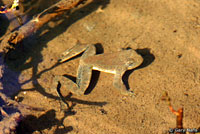 |
|
| Couch's Spadefoot Calling while floating on the surface of a temporary rain pool. | Foothill Yellow-legged Frogs have small vocal sacs which produce a weak sound. They live around fast-moving noisy streams which can cover up their calls, so they also call from underwater, as seen on the right. |
|
 |
 |
|
| Typically, this species calls from the edge of the water at night, but this short video shows a male Pacific Treefrog calling while on a high-altitude pond during daylight. |
Northern Red-legged Frog calling underwater in Humboldt County, CA. I recorded this frog with an underwater microphone. You can hear it here. | In this short video shows a Rio Grande Leopard Frog calling at night, using his throat sack as well as pouches on the side of the neck to produce a variety of sounds. Another Rio Grande Leopard frog joins in and they are both accompanied by an American Bullfrog. |
 |
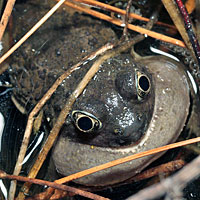 |
 |
| Lowland Burrowing Treefrog The vocal sacs of this frog extend all the way around the mouth. |
Great Basin Spadefoot | Western Green Toad |
 |
 |
 |
| New Mexico Spadefoot Calling while floating on water |
Squirrel Treefrog | Houston Toad |
 |
 |
 |
| In this short video a male California Toad picked up out of the breeding pond makes the release call, then swims away. | In this short video, you can see a Boreal Toad giving a release call after he is picked up and gently grasped across the back. (It may sound like this toad is suffering, but it was not harmed. This is a warning call, the same one he makes when another male toad comes into his territory or climbs onto his back.) | In this short video an adult male Sierran Treefrog makes a one-part call while floating on the water on a sunny afternoon in Contra Costa County. |
 |
 |
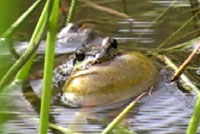 |
| In this short video three adult male Sierran Treefrogs make their advertisement call one afternoon in early March in Contra Costa County. | In this short video we see three adult male Sierran Treefrogs make their encounter call. These calls were elicited by making a raspy noise near the frogs as they were sitting on the water in calling position. The call of each frog is slightly different. | In this short video a male Sierran Treefrog makes a few advertisement calls, until a second frog between him and the camera, makes a raspy trilled encounter call. The first frog responds with his encounter call, but when the second frog continues, he then turns to face his aggressor and charges toward him, continuing to make his encounter call. The second frog changes his call to a faster one part call. Finally they both stop, and the first frog sucks in his throat sac and dives underwater. |
 |
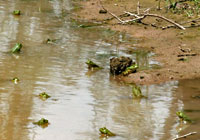 |
 |
| In this short video a male Baja California Treefrog calls at night as part of a chorus of frogs in Kern County. He starts with the two-parted call, then speeds up a bit slurring the two parts together into what is almost a one-part call which he then alternates with the two-parted call. | American Bullfrogs are a pest in the West, where in some areas they are very abundant, especially with frogs that are not yet full-grown adults.These sub-adults and juveniles usually chirp and jump into the water or onto the shore when they are frightened. (This is an alarm call.) In this short video, hundreds of them put on a show with a chorus of chirping alarm calls accompanied by splashing and skipping across the water. | In this short video a big male American Bullfrog calls from the edge of a lake in the daytime. He sat making single calls every few minutes, until suddenly lots of other bullfrogs began calling all around him and then he made his full calls. Here we see him start with a full series of calls, then wait a bit before making a second series of calls, but this time starting with some longer notes before doing his typical calls. There was a second male about 10 feet from him who was silent, but after the first male makes his second full series of calls, the second male begins calling at 1 minute 10 seconds into the video. We can't see him, but his calls sound about as loud as the first frog, but you hear them when you can see that the first frog is silent. This calling disturbed the first frog so much, he made a short, sharp, territorial call and leaps in the air in the direction of the second frog. When I finally found him again, he was closer to the second frog, but the second frog hadn't moved. |
 |
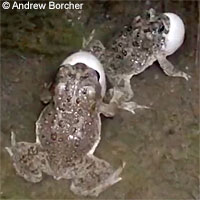 |
|
| An adult male Western Spadefoot calls at night in a shallow creek in San Diego County. © Andrew Borcher | Two male Arroyo Toads compete for position in a breeding creek in San Diego County, wrestling with each other, then both calling at the same time. (Baja California Treefrogs can be heard calling in the background.) © Andrew Borcher |
|
Return to the Top
© 2000 -


